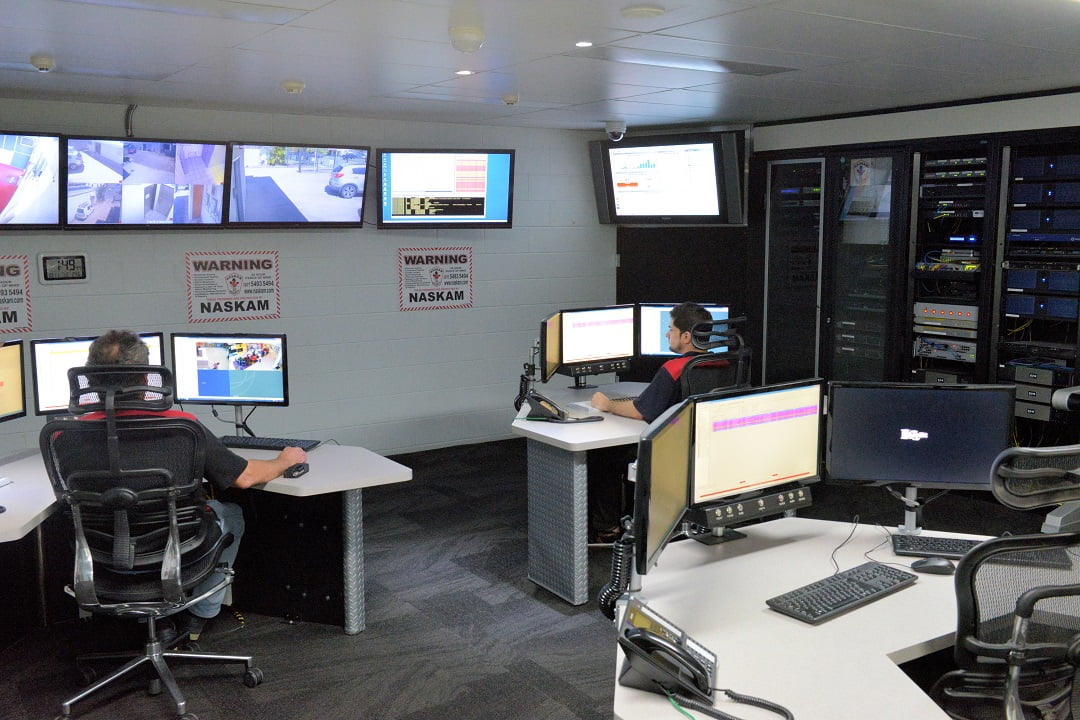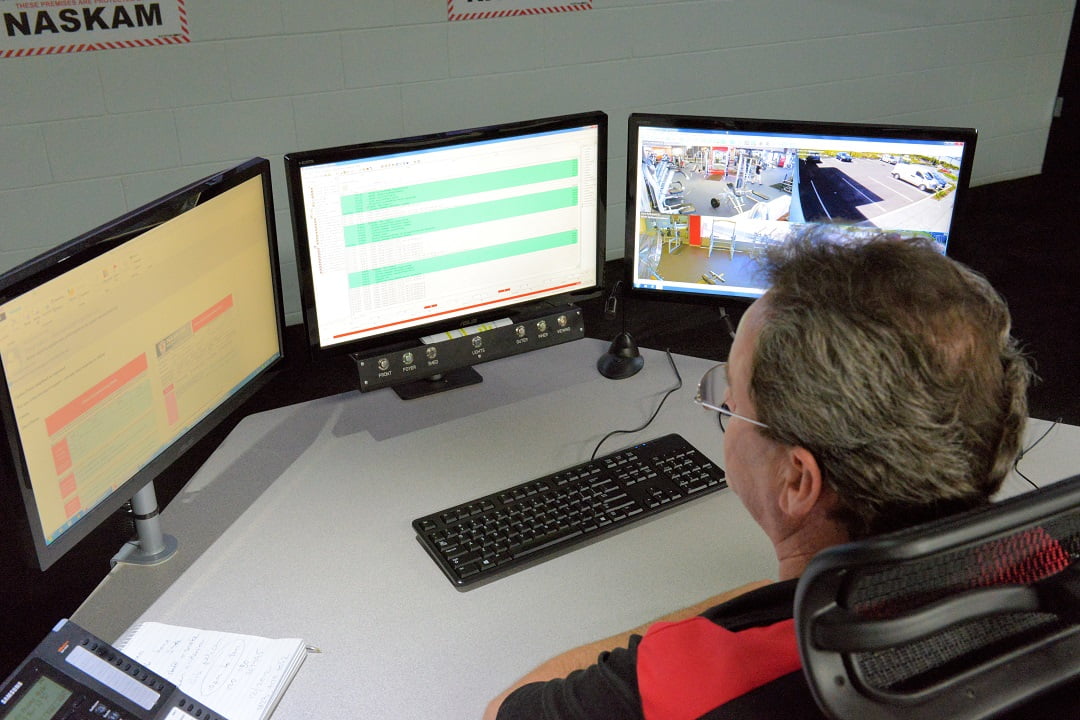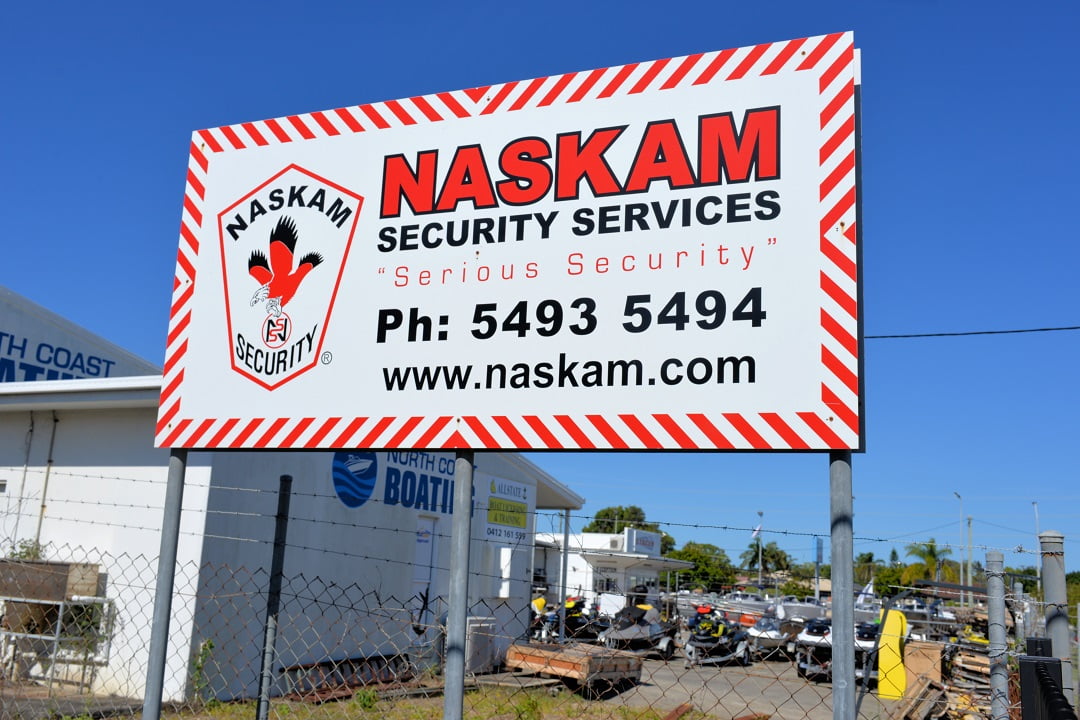Rapid penetration by telcos and huge ISPs into the security and automation markets with low cost hardware and bundled alarm monitoring services is presenting monitoring companies with an uncertain future. How they respond will be the key.
NASKAM Security on Queensland’s Sunshine Coast is a boutique electronic security business. Founded by Maks Maksan in 1986, the company combines Grade 1A monitoring and a security integration business in a symbiotic relationship that has brought decades of growth. With electronic security integration in the stable, it’s not surprising that Makson and his team are at the sharp end when it comes to adoption of new technology. Without the large line volumes of bureau monitoring services, Naskam has always had to offer its customers something extra.
A decade ago, the company launched live monitoring of video surveillance systems for remote patrols and video verification, using IndigoVision cameras and IndigoVision software specifically designed for low bandwidth communications paths. The inclusion of serious video surveillance capability in its monitoring station enhanced Naskam’s offering and impacted on the mindset of the company, expanding its view of the future. And the future of the alarm monitoring industry is a nebulous thing. No matter which way control room owners turn, there are threats to the old ways.
There are threats to rusted-on revenue streams, the challenge of the PSTN sunset, the creeping technological hydra of the NBN, the demands of the connected consumer and the challenge of corporates bundling alarm monitoring services with crushing economies of scale. The threats are of such magnitude that they challenge not just business models but the nature of the underlying systems that support them. Perceiving this, Naskam management realised it needed to change and not just reinvent itself but reinvent its capacity to respond to a market segment in which certainty was a thing of the past.

According to Maksan, Naskam is a highly flexible solutions provider and this has stood the team in good stead as they’ve worked to move forward on their new monitoring platform.
“We could see the monitoring business was changing fast and we knew we could no longer do things in the way we have done,” he says. “We needed to do something different, to offer our customers additional services and functionalities. These are the core reasons we took on Bold Technologies’ ManitouCS monitoring package – it allows us to meet our customers’ changing needs in a rapidly changing market.”
Challenges in the market
Speaking with Maksan and Naskam general manager, Chad Wright, the subject of the future is always in the air over the boardroom table, a palpable presence. The driving force here is profound – survival and future prosperity – not a languid process of upgrade. The management team displays an intense awareness of the way unfolding changes are impacting on every layer of the business. At the heart of all this is giving customers something they want to pay for – offering them a compelling service.
According to Naskam’s general manager, Chad Wright, in order to survive the threats posed by telcos, ISPs and a trend towards self-monitoring of domestic alarm panels, central stations need to be able to offer customers significant advantages.
“We need to give more to our customers, we need the capacity to give customers more engagement with their systems,” Wright explains. “In our case, we’ve been planning this transition for years when it comes to new services we offer, but you also have to have a plan for your existing customers and this is a challenge facing all monitoring centres.”

Wright believes the demographic central stations will be dealing with over the next 5 years will have a higher expectations of improved functions in domestic and commercial applications – this is something all central stations must address.
“Younger residential and business owners have different expectations,” Wright explains. “They are very connected with mobile devices and they are used to interacting with technology. Something we find with security systems is that we are selling the interface rather than the functions of the panel itself. People are invested in the interface – most people don’t want to look at detectors – they care about touch screens. We can’t sell the same system as others – we have to justify the additional expense.”
And there are the pressing challenges of big new players.
“We have a situation where there are powerful new competitors and with the NBN coming, there is the potential for a negative impact on traditional alarm monitoring markets,” Wright says. “We knew we needed to offer something special, something different and something worth paying for. We needed a solution that gives us those abilities, those points of difference – a system that takes security monitoring to another level. We needed alarm panels with video verification, automation, with the ability to handle any inputs and outputs and any signals and we needed high level bi-directional communication with the control panel.”
Selecting the system
At the core of the process of future-proofing the Naskam monitoring business is selecting a central station software platform that has the power, flexibility, functionality and long-term support necessary to make it a worthwhile investment. Key aspects of the new system include support for Naskam’s video monitoring services.
“We’ve been doing video in our control room for the last 10 years and it’s a key part of the business,” explains Maksan. “We have 2 types of video verification here – we have things like Risco and Videofied but we also do live video for major clients in retail, government and mining with IndigoVision. We quickly came to the conclusion that whatever we took on board had to offer more than traditional alarm monitoring and needed support more than just a few camera systems, more than the industry is currently doing.
“Bold Manitou gives us the capability to handle video seamlessly, as well as offering many other functions. It’s powerful but flexible so that if we need to, we can adjust the shape of our solution as we go along. And there’s regular interchange between operators and monitoring station owners/managers with Bold – it allows all of us to stay up to date and share ideas and efficiencies – that sense of community is important.”
According to Wright, Bold ManitouCS offers high levels of automation and integration.
“What Bold offers with ManitouCS is a package that does all the things we needed our new system to do,” says Wright. “We’ve got the UniversalConnector, which allows us to integrate with literally anything. It’s a software receiver that turns SMS, Email, ODBC database, FTP, TCP, GPRS, RSS, UDP and simple files into regular signals that are delivered into ManitouCS as GPS, video, or audible alarms events.
“As well as GPS tracking, there’s a new service called B Shield which allows us to do tracking and duress on smart phones. There’s also integration with iView and iMix which allows us to do video verification of pretty much every CCTV system and which gives us an operator audit trail. And all this and more is already worked into Bold – there’s no development,” Wright says. “There are now so many integrations we can do, there are future services, there’s the support factor and the Bold Genius training solution. There’s no other monitoring software that has the level of training and functionality that Bold offers.”

Vital, given the state of the market, Bold functionality goes in both directions.
“What Bold also brings us auto-text, interactive 2-way communication with clients via an app and a level of automation that means the operator only intervenes when they need to,” Wright explains. “For instance, alarm events might only appear to the operator when there is video verification of an event. All of a sudden you can manage busy times without an additional operator, and when you reduce the amount of work that the operator is doing, you create additional efficiency, allowing operators to work on other things.”
While Naskam has not offered bureau monitoring services up until now, it will in the near future, with several integrators already looking to change service providers.
“With most monitoring centres that bureau, the installer has very limited engagement with end users,” explains Wright. “But with Bold there’s an app for technicians for commissioning and trouble shooting and there’s also BoldNet, so we can offer bureau installers the ability to remotely access their systems in multiple ways, including data input options if desired.”
The upgrade process
“Obviously with a process like this, completely replacing a live central station’s software, local support is vital?” I ask.
“Yes, it is and Bold and local distributor, SCSI, have been excellent in that regard,” says Maksan. “It’s great to have such strong support from Bold as well as having a local distributor making sure we have what we need. SCSI is full committed to the system and has invested in training staff – you need to have someone in Australia you can talk to about the product so they are championing what you need with the manufacturer. That was a big thing – we needed to make sure we were not on our own. Taking on Bold is a significant investment and we needed to be sure we would get the ongoing support we needed. You want to be able to ring someone during the day in Australia and get immediate support and that’s what SCSI has been able to offer in conjunction with Bold.”
How long has the process being going on – you and JD Security are the first local control rooms to install Bold – are you fully operational on Manitou?
“We started running signals into Bold in May – all our data is now converted,” says Wright. “We are actioning from Bold right now but running our old system in the background – we have signals going into both systems. From a grading perspective, we need to access historical events so we need to retain that capability to allow operators to access event archives and we always over specify everything in our control room. We’ve not needed to fall back on the old system – Bold has been very stable and is working well.
“Was it a difficult process switching to Bold?” I ask.
“We came to this process with our eyes wide open,” explains Wright. “A lot of control rooms when they switch software will leave things as they are – they change platforms but not the way they do things – they don’t change their functionalities. We had a different approach – we knew Manitou was very different, we wanted it to be different. There have not been stand-out challenges but it’s been a whole-of-business process. We have been going to a select group of our clients saying – there are the new things you can do, this is a new level of access you can have, this is the level of automation we can build. We now offer the full capabilities of ManitouCS as our standard monitoring service and that was the whole point of the change.”
Driving the system
Given Bold Manitou’s flexibility and power, you’d expect the functionality in the monitoring station to feel different and it does. From the operator’s perspective, ManitouCS is an active component of the monitoring process.
“With some monitoring systems when an operator gets an alarm they read notes which tell them what to do but there’s room for operator interpretation – in Bold the response is programmed in,” says Wright. “The operator receives the alarm event and goes to action it and there is one choice. There may be additional choices but the system has already decided based on a range of factors, what the correct choice must be.
“This leaves no room for error or misinterpretation, no long list of options to make sense of – in this case, do this, in this case, do this – and that makes response times faster. Our operators don’t have to think about what to do in high stress situations – they just have to act and that’s better for customers and better for control room managers and better for operators.”

“The pace of the world is faster and when business people are out of the office they don’t want to have to make decisions relating to security events – the automation process follows agreed procedures and customers do not need to be interrupted from sleep or family time in order to decide whether or not to send a patrol. Often people will not even answer a call from a number they are not familiar with and the process of ringing through a list delays operator response. ManitouCS automation resolves that dilemma – what has been designated to happen in a given event, always happens in a given event.”
Maksan agrees.
“ManitouCS works very well,” he says. “Things going on in the background the operator does not need to be bothered with – basic entries and exits and general notifications that can fill up an event log – there’s none of that. Instead the operator sees the events that are important and is told how to action those events – the priority for the operator is action and this frees up time for other responsibilities.”
Touring the control room
Next, we take a tour of the monitoring centre, getting in through the mantrap double doors. The space is open, there are 3 workstations, a compact server rack along one wall, offices and other facilities at the rear. The atmosphere is quiet as the operators get on with their work, part of which is monitoring customer video feeds. The workstations view video walls and each desk has multiple screens handling different systems in real time. It’s a functional space that allows easy communication between supervisors and other operators.
We take a look at a workstation which is running ManitouCS, IndigoVision and administrative functions on 3 separate screens. According to Wright, the consoles have been designed to allow operators full peripheral vision of the monitors so events on any screen will be drawn to their attention. They might see an alarm and then the IndigoVision system will pop video up onto an adjacent screen so they can manage multiple things at a time. The third screen allows operators to be working on emails or upload/downloads when dealing with technicians over the phone.

I pay attention to the video coming through on the workstation screens from shopping centres – 1080p IndigoVision BC cameras coming in on 4G and other links. The performance is strong – good depth of field, colour rendition, sharpness and WDR. The image streams are running at 12.5 frames per second. There are three 20Mb pipes coming into the control room to assist handling the remote video, which seems quite modest, given the quality of the image streams.
“Bold is currently doing a high level interface for us so the hundreds of IndigoVision cameras we monitor live will come directly into the monitoring software via our VPNs,” Wright explains.
“How long did it take to learn the new monitoring software?” I ask the operators.
“I didn’t take long – a couple of months to get completely across it,” says Peteer, the shift supervisor. “We did a lot of training online. It’s definitely more capable than the old system.”
Conclusion
Maksan and Wright are proud of the Naskam central station’s history of over-specification and I get a strong sense the company’s investment in Bold ManitouCS is an expression of this cultural willingness to re-invest in the business. And as they run through the specifications of their new solution, it’s impossible not to agree that the future is already demanding levels of flexibility and support many in the monitoring industry are not equipped to deliver.
Talking with the boys, I also get a sense of their caginess. Makson points out that while they believed in the Bold product, they chose not to go to Colarado Springs so as to ensure they didn’t become emotionally invested in the system. Instead, they wanted to make their decision with clear heads. Revelations like this typify the importance of ManitouCS to Naskam. It really is their entire future and they know it. This deep engagement with what will work best in the long term is good news for Naskam customers.
“If we don’t go to our clients and offer them all the functionality of Bold, the entire exercise of moving to a new software platform is meaningless,” Maksan says. “The best interaction and integration functionality Bold offers will be our standard monitoring service and our customers and our operators are coming with us. The result will be far more capable security solutions and far greater levels of efficiency.” ♦
By John Adams
Features of Bold Technologies’ Manitou CS include:
* Process alarms and signals quicker through standard features and add-on modules
* Increase accuracy and reduce training times with action patterns and workflows
* Handle customer base efficiently, whether 5000 accounts or over 5,000,000
* Maintain control with standard Windows conventions, easy keyboard and mouse use
* Protect users from getting lost under a shower of windows with Manitou Navigator
* UL 1981 Certified for Central Station and Control Rooms
* Includes the SnapReporter module to easily create custom reports.









